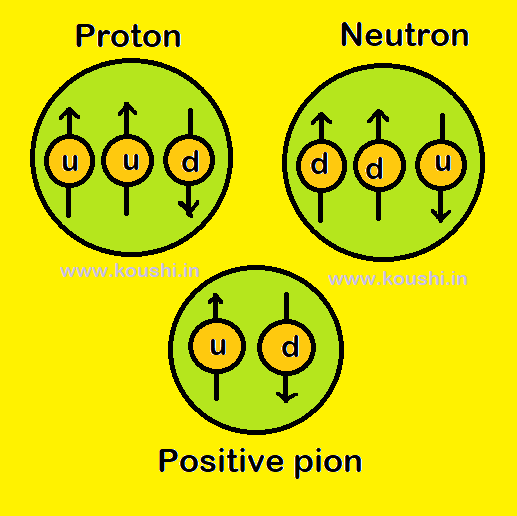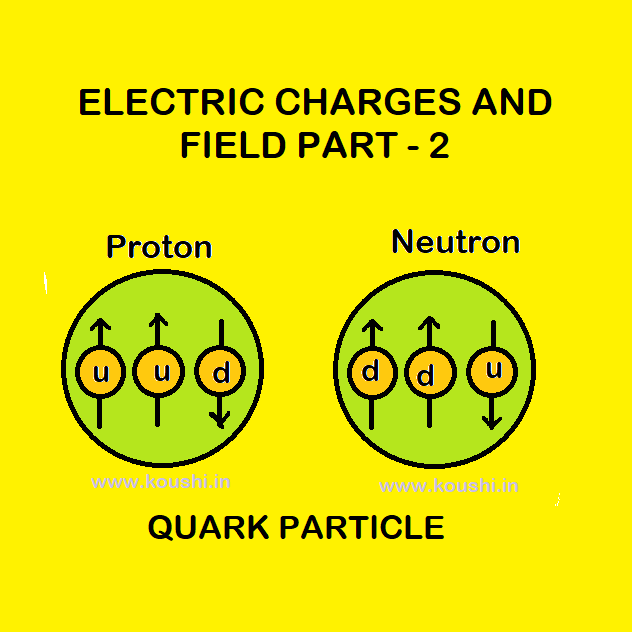Quantization of charge: Quantization is the property of an electric charge by virtue of which all observable charged body can have charge which is an integral multiple of the basic or elementary charge ‘e’ (e = 1.6 ![]() 10-19 C).
10-19 C).
I.e. Q = ![]() ne where Q is the total charge of a body and n 1, 2, 3 ….
ne where Q is the total charge of a body and n 1, 2, 3 ….
Thus, anybody of charge Q must be an integral multiple of |e|.
That is Q = 0, ![]() e,
e, ![]() 2e,
2e, ![]() 3e etc.
3e etc.
Quarks: Quarks are truly elementary particles which carry charges fraction of electronic charge (i.e. ![]()
![]() and
and ![]()
![]() ) and have spin +
) and have spin + ![]() . There are 6 types of Quarks. up (u), charm (c), top(t) all having charge +
. There are 6 types of Quarks. up (u), charm (c), top(t) all having charge + ![]() and down (d), strange (s), bottom(b) all having charge –
and down (d), strange (s), bottom(b) all having charge – ![]() . The antiquarks particles are designated by an overbar and have oppositely charges compared with those of corresponding quarks (anti-up of charge –
. The antiquarks particles are designated by an overbar and have oppositely charges compared with those of corresponding quarks (anti-up of charge – ![]() ).
).
A proton consists of two ‘up’ quarks and one ‘down’ quark, i.e. ‘uud’ and a neutron consists of one ‘up’ quark and two ‘down’ quarks, i.e. ‘udd’.
A positive pion (π+) consists of one ‘up’ quark and one ‘anti down’ quark, i.e. ‘ud̅’.

The relation between different units of charge:
1 emu of charge = 3 ![]() 1010 esu of charge
1010 esu of charge
1 coulomb of charge = 3 ![]() 109 stat coulomb
109 stat coulomb
1 abcoulomb = 10 coulomb.
Continuous charge distribution:
A continuous charge distribution is a system of charges lying at infinitesimally small distances from each other. There are three types of continuous charge distribution.
1. Linear charge density:
Linear charge density is charge per unit length. If q charge is distributed uniformly over a line of length L then the linear charge density λ = ![]() .
.
SI unit is Cm-1.
If ![]() q is the charge contained in a small line element
q is the charge contained in a small line element ![]() L then the linear charge density λ =
L then the linear charge density λ = ![]() . The total charge q =
. The total charge q = ![]() dq =
dq = ![]() .
.
2. Surface charge density:
Surface charge density is charge per unit area. If q charge is distributed uniformly over a surface s, then the surface charge density σ = ![]() .
.
SI unit is Cm-2.
If ![]() q is the charge contained in a small area element
q is the charge contained in a small area element ![]() s then the surface charge density σ =
s then the surface charge density σ = ![]() . The total charge q =
. The total charge q = ![]() dq =
dq = ![]() .
.
3. Volume charge density:
Volume charge density is charge per unit volume. If q charge is distributed uniformly over a volume v, then the volume charge density
ρ = ![]() .
.
SI unit is Cm-3.
If ![]() q is the charge contained in a small volume element
q is the charge contained in a small volume element ![]() v then the volume charge density ρ =
v then the volume charge density ρ = ![]() . The total charge q =
. The total charge q = ![]() dq =
dq = ![]() .
.
Click the button to go to the next part of this chapter.
Click the button to go to the previous part of this chapter.
